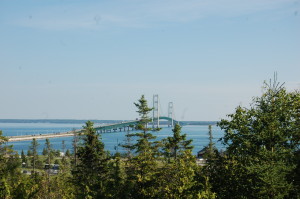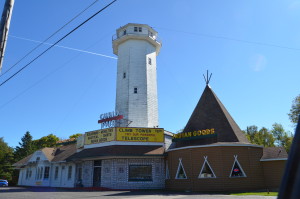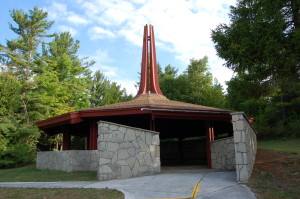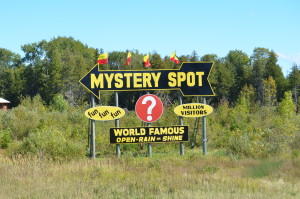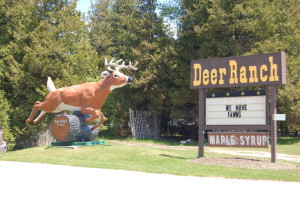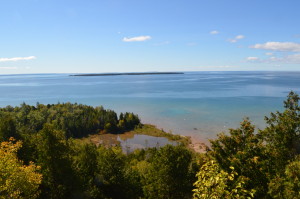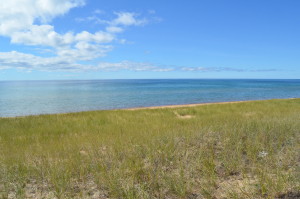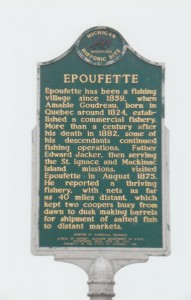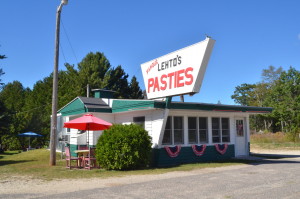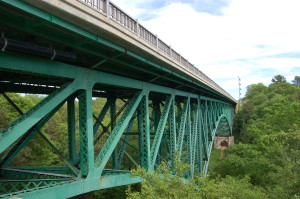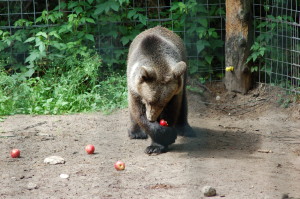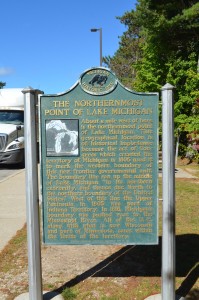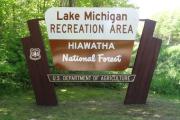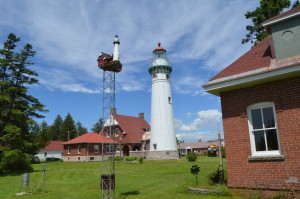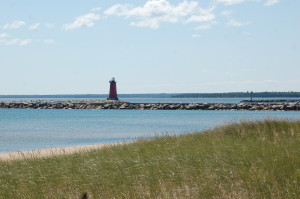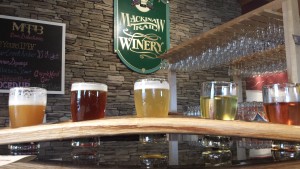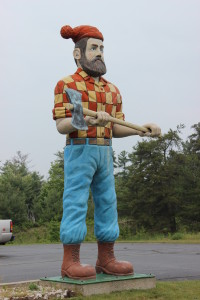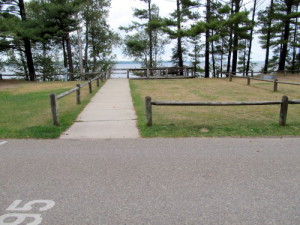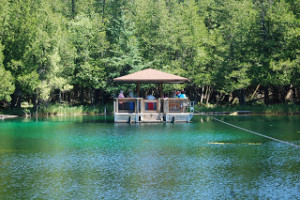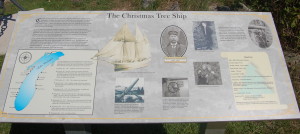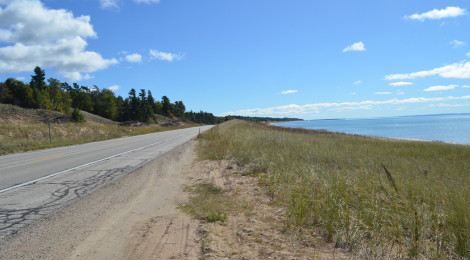
20 Things to See and Do on Michigan’s Newest Scenic Byway
On October 6th, 2017, the stretch of US-2 between St. Ignace and Manistique in the Upper Peninsula was designated as Michigan’s newest scenic byway, the “Top of the Lake Pure Michigan Byway.” We’ve traveled this road many times over the years while heading west to U.P. destinations like Pictured Rocks, Porcupine Mountains, Escanaba, Marquette, Ironwood and other locations. The 92-mile route offers miles of scenic views on Lake Michigan, beaches, pasty shops, historical attractions, family attractions, small towns and more. We put together a list of some of our favorites along this new scenic byway, enjoy this post full of 20 Things to See and Do on Michigan’s Newest Scenic Byway!
Mackinac Bridge views – Great views of the Mackinac Bridge are plentiful in St. Ignace. On US-2 just west of town Curio Fair offers a tall tower attached to a gift shop for optimal bridge viewing. Check out their wide range of Upper Peninsula souvenirs then climb the tower and get a great view of the Mighty Mac! Other top viewing sites include Straits State Park, Father Marquette National Memorial, and numerous roadside pull-offs west of town. (1119 US-2)
Father Marquette National Memorial – This park pays tribute to the founder of St. Ignace, Father Jacques Marquette. A museum here burned down in 2000, leaving just an open-air building with informational kiosks about the life of the famous missionary. There is an interpretive hiking trail, and a few places that offer views of the Mackinac Bridge. (592 Boulevard Dr.)
Mystery Spot – The Mystery Spot is a beloved tourist stop that features two ziplines, an 18-hole mini golf course, a maze, and guided tours of “optical contradictions and physical sensations that are hard to believe.” (N916 Martin Lake Rd.)
Deer Ranch – It’s easy enough to see whitetail deer alongside many of Michigan’s highways, byways and back roads – but the Deer Ranch in St. Ignace lets visitors see deer up close and even feed them. This reasonably priced, family-friendly attraction also features albino deer and fawns and it is located right on US-2 within a short drive from the Mackinac Bridge. www.deerranch.com (1540 US-2)
Gros Cap Lookout – This roadside park six miles west of St. Ignace provides a distant view of St. Helena Island and its lighthouse as well as plenty of room for picnics. The Michigan historical marker here reads: “French fishermen who came to Gros Cap (on the shore below) early last century also participated in its offshore settlement, St. Helena Island, where ships obtained wood fuel and other supplies. There in 1850, Archie and Wilson Newton set up a fishing and shipping business. The community thrived for more than thirty years.” (US-2 six miles west of St. Ignace)
Sand Dunes Beach – About 12 miles from St. Ignace, US-2 treats travelers to a wide open vista of Lake Michigan on one side of the road and sand dunes on the other. When driving through here in the summer months you can expect to see many cars parked on the side of the road as people stop to swim, sunbathe, stretch, or explore the dunes.
Epoufette Lookout – From this roadside park you have a great view of Lake Michigan and the fishing village of Epoufette. A Michigan historical marker provides some background: “Epoufette has been a fishing village since 1859, when Amable Goudreau, born in Quebec around 1824, established a commercial fishery. More than a century after his death in 1882, some of his descendants continued fishing operations. Father Edward Jacker, then serving the St. Ignace and Mackinac missions, visited Epoufette in August 1875. He reported a thriving fishery, with nets as far as 40 miles distant, which kept two coopers busy from dawn to dusk making barrels for shipment of salted fish to distant markets.” Park located a few miles west of the Cut River Bridge.
Pasties! – Suzy’s Pasties (St. Ignace), Lehto’s Pasties (St. Ignace), Hiawatha Pasties (Naubinway), Three Seasons Cafe (Manistique), and The DownTowner (Manistique) are just a few of the options for those looking to try the Upper Peninsula’s signature dish – a pastry filled with meat and vegetables.
Cut River Bridge – This bridge located 25 miles west of St. Ignace was constructed in 1947 and is one of only two cantilevered steel truss bridges in Michigan. It is 641 feet long and carries US-2 traffic more than 140 feet above the Cut River and valley below. Various walking paths lead below the Cut River Bridge, which was renamed the Heath M. Robinson Memorial Cut River Bridge in 2014 to honor a Navy SEAL killed in action in Afghanistan.
GarLyn Zoo – The largest zoo in the Upper Peninsula opened its doors in 1994, and has been providing families with up-close animal encounters ever since. Located less than an hour from the Mackinac Bridge, GarLyn Zoo hosts otters, bears, llamas, wolves, bobcats, alligators, bison and many other native North American species. Visitors will also find tigers, camels, lemurs, camels, tortoises and other exotic animals. www.garlynzoo.com
Northernmost Point of Lake Michigan/Rest Area – At a roadside rest area three miles east of Naubinway, you are incredibly close to being at the northernmost point of Lake Michigan. There is a Michigan historical marker here, noting “This geographical location is of historical importance because the act of Congress which created the territory of Michigan in 1805 used it to mark the western boundary of this new frontier governmental unit. The boundary ran up the middle of Lake Michigan ” to its northern extremity, and thence due north to the northern boundary of the United States.” West of this line the Upper Peninsula was part of Indiana Territory. In 1818, Michigan’s boundary was pushed west to the Mississippi River. All of the U.P., along with what is now Wisconsin and parts of Minnesota, came within the limits of the territory.”
Top of the Lake Snowmobile Museum – This museum showcases antique, vintage and classic snowmobiles and is open all year. They also hosts a variety of events, including December’s Snowmobile the Mighty Mac Bridge Crossing. Admission rates and other info can be found at http://www.snowmobilemuseum.com/. (W11660 US-2, Naubinway)
Lake Michigan Campground – There are plenty of opportunities to explore the Hiawatha National Forest along the Top of the Lake Scenic Byway, but the Lake Michigan Recreation area stands out for its scenic views and camping opportunities. There are 35 rustic sites here for tents and trailers, with most sites only a few hundred feet from the Lake Michigan beach. Details can be found on the Hiawatha National Forest website. Campground is located 16 miles west of St. Ignace.
Seul Choix Point Lighthouse – Marking the only harbor of refuge between St. Ignace and Manistique, the Seul Choix Point Lighthouse has been a navigational aid since 1892. The 75 foot tall tower and attached keeper’s dwelling near Gulliver are open to the public as part of a museum complex, and are also rumored to be haunted. You can check out Photo Gallery: Seul Choix Lighthouse Tour post for a better look at the lighthouse grounds, for hours and other info visit http://www.greatlakelighthouse.com/.
Manistique Boardwalk and East Breakwater Light – The boardwalk and river walk starts roughly two miles east of Manistique and takes visitors past Lake Michigan views, a sandy swimming beach, a fishing pier, and the iconic Manistique East Breakwater Light. When weather conditions allow, it is possible to walk out to the lighthouse, which is a 38 feet tall square-pyramidal steel tower.
Mackinaw Trail Winery and Brewery – We’ve already shared how much we loved visiting the Mackinaw Trail Winery and Brewery in Petoskey, but Manistique is where things got started back in 2004. Stop by the On the Harbor Tasting Room (103 W. Lakeshore Dr.) to try some of Mackinaw Trail’s award-winning wines or sip on a few of their craft beer offerings. http://www.mackinawtrailwinery.com/
Paul Bunyan Statue in Manistique – A 15 foot tall sculpture of Michigan’s legendary lumberjack sits in front of the Schoolcraft County Chamber of Commerce building on US-2 just east of Manistique. This is one of five Paul Bunyan statues featured in out Paul Bunyan Statues in Michigan post.
Indian Lake State Park – Centered around the fourth largest inland lake in the Upper Peninsula, Indian Lake State Park has a 145-unit modern campground and a 72-site semi-modern campground. The park also has two miles of hiking trails and endless opportunities for outdoor recreation on and around the lake. Take M-149 north from US-2 to reach the park.
Big Spring Kitch-iti-kipi – Located in Palms Book State Park (a day use only state park), Kitch-ti-kipi is one of the Upper Peninsula’s most amazing natural wonders. Visitors can take a self-propelled wooden raft out onto the spring, where 10,000 gallons per minute bubble up from below at a constant temperature of 45 degrees. The park is located on CR-449, roughly 12 miles northwest of Manistique. See our Photo Gallery Friday: Big Spring Kitch-iti-kipi for more photos and information.
“Christmas Tree Ship” Historical Marker and Roadside Park – A roadside park near Thompson features several markers that tell the history of the Rouse Simmons, the “Christmas Tree Ship.” The Michigan historical marker reads: “Built in 1868 to carry lumber, the three-masted vessel became Chicago’s “Christmas Tree Ship” when Herman Schuenemann purchased an interest in it in 1910 Around 1876 the Schuenemanns had begun transporting trees from northern Michigan and Wisconsin to Chicago. In November 1898 Herman’s brother August perished in the wreck of the Schooner S. Thal, but Herman continued in the business. Bound for Chicago on November 22, 1912, he boarded the Simmons which was loaded with trees from Thompson’s forests, and sailed into a fierce snowstorm that plunged the ship and its crew and passengers, to the lake bottom.”

